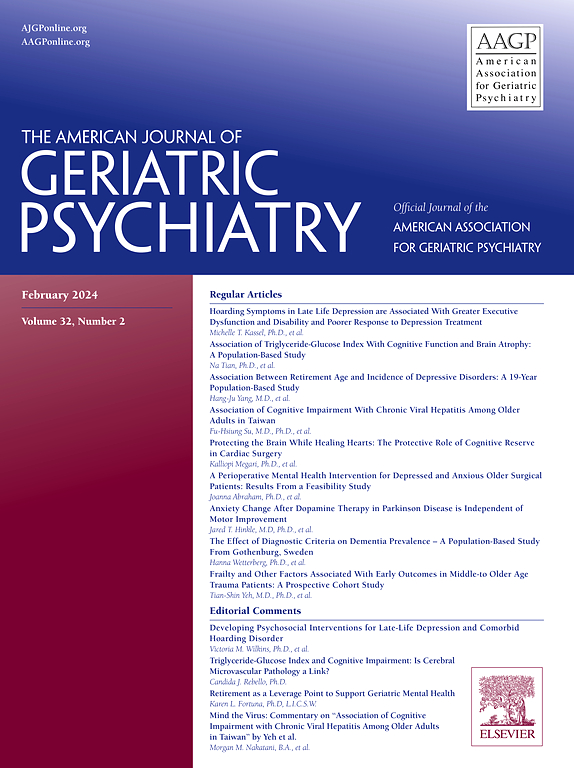36. 另一种二元论:认知与人格对晚年抑郁中反刍的预测
IF 3.8
2区 医学
Q1 GERIATRICS & GERONTOLOGY
引用次数: 0
摘要
反刍是抑郁症的一个易感和持久特征,与人格和认知变量有关。然而,人们对它们对反刍的相对影响知之甚少。这项研究考察了人格和认知作为早发性、晚期生活抑郁症(LLD)的预测因素,对于那些有或没有抑郁症史的人来说。探索性分析在当前抑郁发作(状态抑郁)的患者亚群中调查了这种关系。方法研究对象为76名年龄在55-79岁的成年人,分为两组:“曾经抑郁”组(N=35),包括当前抑郁或抑郁症缓解者,和“从未抑郁”组(N=41),包括无抑郁史者。探索性状态抑郁分析考虑了当前抑郁发作的“曾经抑郁”组的子集(N=18)。人格预测因子是通过NEO- pi - r (NEO- pi - r)评估的五个领域:开放性、严谨性、外向性、宜人性和神经质。认知预测因子是根据理论和现有文献的支持来选择的,包括执行功能(Trail Making Test B, D-KEFS Color-Word Interference Condition 3, Wisconsin Card Sorting Test持之以恒的反应)、注意力(WAIS-IV Digit Span Forward)和整体认知能力(Mini Mental Status Test)。采用层次线性回归模型对反刍预测因子进行综合分析,变量块由1)人口统计学因素(年龄、性别、教育程度),2)抑郁史(曾经/从未抑郁过),3)所有认知和人格变量,以及4)WCST持续性错误和NEO-PI神经质的交互项(抑郁史x变量)组成,这是第3块中唯一具有显著交互作用的变量。探索性分析考虑当前抑郁发作患者的结果是否受到抑郁严重程度的影响,采用分层回归变量区块:1)人口因素(年龄、性别、教育程度),2)MADRS评分,3)WCST持续性反应和NEO-PI神经质因子评分,以及基于抑郁严重程度(MADRS总分x变量)的相互作用项。结果在初步分析中,抑郁史是反刍的重要预测因子,并且在纳入所有认知和人格变量后仍然具有重要意义。神经质(β=。39, p < 0.001)和WCST持续性反应(β=0.18, p < 0.05)显著预测反刍,尽管它们与抑郁史的相互作用不显著。在纳入交互作用项后,MMSE成为反刍的显著预测因子(β=)。17, p < 0.05),尽管最初不显著。在探索性分析中,MADRS评分显著预测状态性抑郁症患者的反刍行为,占协变量之外方差的55.7% (R2=)。69, F(1,13)=23.2, p < 0.001)。在纳入神经质因子评分、WCST持续性反应及其与MADRS评分的相互作用项后,没有一个预测变量与反刍水平显著相关。在考虑了各种社会人口变量后,抑郁史可以预测LLD的反刍行为,证实了先前的研究表明,特质性抑郁会增加老年人反刍行为的风险。神经质对反刍有显著的预测作用,表明个性可能增加抑郁症状的易感性,而与抑郁病史无关。在所考虑的认知领域中,只有认知灵活性(WCST持续性反应)与反刍有关。关于MMSE表现对反刍水平的贡献的模棱两可的发现可能表明LLD中人格和认知之间存在更复杂的潜在关系,尽管这种联系需要进一步研究。对状态抑郁组的探索性分析并没有复制那些在综合分析中显著的预测因子的显著性,这表明反刍的预测因子可能在状态和特质水平的抑郁中有所不同。总体而言,结果暗示人格因素,即神经质,比认知更能预测老年人的反刍,尽管这种关系可能在状态性和特质性抑郁中有所不同。本文章由计算机程序翻译,如有差异,请以英文原文为准。
36. ANOTHER DUALISM: COGNITIVE VERSUS PERSONALITY PREDICTORS OF RUMINATION IN LATER LIFE DEPRESSION
Introduction
Rumination, a predisposing and perpetuating feature of depression, has been linked to personality and cognitive variables. However, little is known about their comparative influence on rumination. This study examined personality and cognition as predictors of rumination in early-onset, later life depression (LLD), for those with and without a history of depression. Exploratory analysis investigated this relationship in the subset of patients in a current depressive episode (state depression).
Methods
Participants were 76 adults aged 55-79 divided into two groups: “ever depressed” (N=35) including those with current or remitted depression, and “never depressed” (N=41) including those with no history of depression. A subset of the “ever depressed” group in a current depressive episode (N=18) were considered in the exploratory state depression analysis. Personality predictors were the five domains assessed by the NEO Personality Inventory – Revised (NEO-PI-R), openness to experience, conscientiousness, extraversion, agreeableness, and neuroticism. Cognitive predictors were selected based on theory and existing support in the literature for their association with rumination, and included measures of executive function (Trail Making Test B, D-KEFS Color-Word Interference Condition 3, Wisconsin Card Sorting Test Perseverative Responses), attention (WAIS-IV Digit Span Forward), and global cognitive ability (Mini Mental Status Exam).
The omnibus analysis was conducted using hierarchical linear regression modelling for predictors of rumination, with variable blocks composed of 1) demographic factors (age, sex, education), 2) depression history (ever/never depressed), 3) all cognitive and personality variables, and 4) interaction terms (depression history x variable) for WCST Perseverative Errors and NEO-PI Neuroticism, the only variables with significant interaction effects in Block 3. Exploratory analysis considered whether results were influenced by depression severity for those in a current depressive episode, with hierarchical regression variable blocks of 1) demographic factors (age, sex, education), 2) MADRS score, and 3) WCST Perseverative Responses and NEO-PI Neuroticism Factor Score, along with their interaction terms based on depression severity (MADRS total score x variable).
Results
Depression history was a significant predictor of rumination in the primary analysis and remained significant following inclusion of all cognitive and personality variables. Neuroticism (β=.39, p LESS THAN .001) and WCST Perseverative Responses (β=0.18, p LESS THAN .05) significantly predicted rumination, though their interaction terms with depression history were nonsignificant. After inclusion of the interaction terms, MMSE emerged as a significant predictor of rumination (β=.17, p LESS THAN .05), despite initial nonsignificance.
For the exploratory analysis, MADRS score significantly predicted rumination in those with state depression, accounting for 55.7% of variance beyond the covariates considered (R2=.69, F(1, 13)=23.2, p LESS THAN .001). After inclusion of Neuroticism Factor Score, WCST Perseverative Responses, and their interaction terms with MADRS score, none of the included predictor variables were significantly associated with rumination levels.
Conclusions
Depression history was predictive of rumination in LLD after accounting for various sociodemographic variables, affirming prior research that indicates trait depression confers an increased risk of rumination in older adults. Neuroticism was significantly predictive of rumination, indicating personality may increase vulnerability to depressive symptoms regardless of depression history. Of the cognitive domains considered, only cognitive flexibility (WCST Perseverative Responses) was associated with rumination. Equivocal findings regarding the contribution of MMSE performance to rumination levels may suggest more complex underlying relationships between personality and cognition in LLD, though this association requires further study.
Exploratory analysis of the state depression group did not replicate the salience of those predictors that were significant in the omnibus analysis, suggesting predictors of rumination may vary for state- and trait-level depression. Overall, results implicate personality factors, namely neuroticism, as more predictive of rumination than cognition in older adults, though the relationship may be distinct for state and trait depression.
求助全文
通过发布文献求助,成功后即可免费获取论文全文。
去求助
来源期刊
CiteScore
13.00
自引率
4.20%
发文量
381
审稿时长
26 days
期刊介绍:
The American Journal of Geriatric Psychiatry is the leading source of information in the rapidly evolving field of geriatric psychiatry. This esteemed journal features peer-reviewed articles covering topics such as the diagnosis and classification of psychiatric disorders in older adults, epidemiological and biological correlates of mental health in the elderly, and psychopharmacology and other somatic treatments. Published twelve times a year, the journal serves as an authoritative resource for professionals in the field.

 求助内容:
求助内容: 应助结果提醒方式:
应助结果提醒方式:


